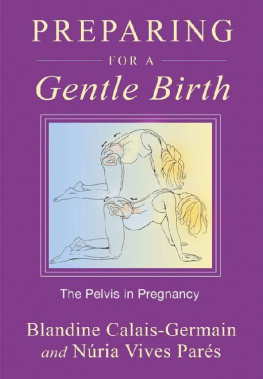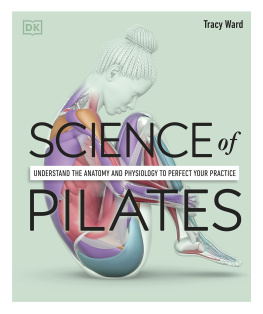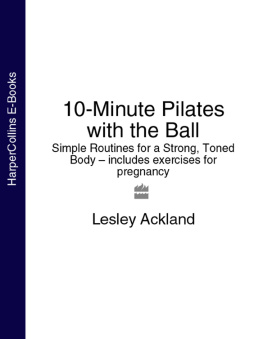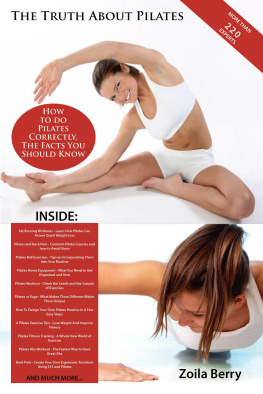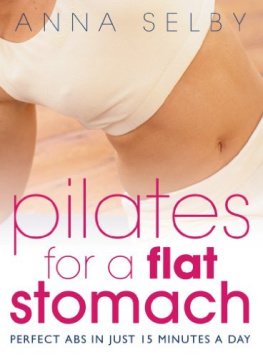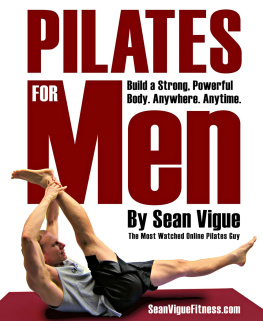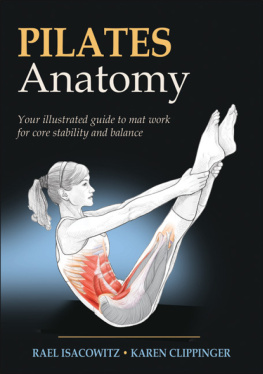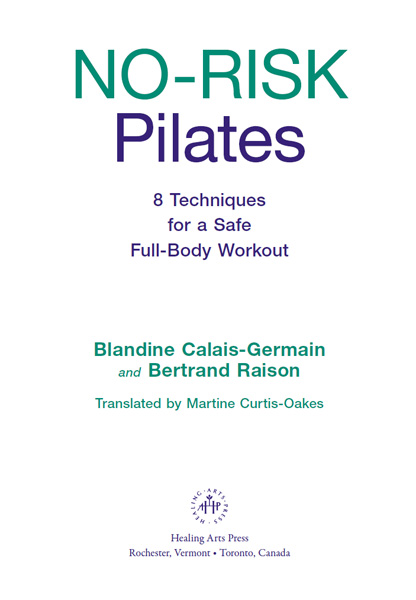

This book is dedicated to Jerome Andrews, an American in Paris, who, taught by Joseph Pilates, was one of the first teachers of the Pilates method in France. A choreographer and dancer, he had a passion for making his students want to move their carcass.
ACKNOWLEDGEMENTS
The authors would like to thank those who helped with or supported the creation of this work.
Thanks to Martine Curtis-Oakes, owner of A-Lyne Centre de Formation, Paris, France, for all of the fruitful exchanges of information.
Thanks to Simone Ushirobira, who was willing to perform the exercises over and over again during the photo shoots.
Thanks to Franoise Contreras, Brigitte Hap, and Alison Liddiart, for their gracious presence.
Thanks to Florence, for her watchful eye and wisdom.
Thanks to the numerous people who requested this information during Anatomy of Movement workshops, whose questions guided us in the organization of this book.
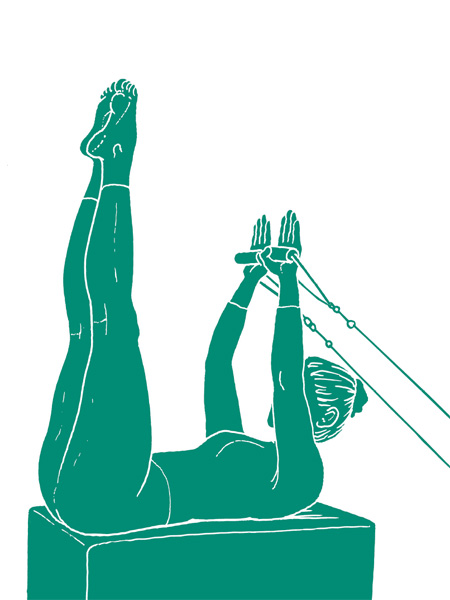
INTRODUCTION
The purpose of this book is to show the anatomical effects of Pilates exercises, specifically of exercises on the Reformer. Using eight exercises as a starting point, No-Risk Pilates explores the logic of each movement and some potential adverse effects. Each chapter examines a specific risk, looks at why it occurs, and proposes solutions. Finally, we look at similar Pilates Reformer and mat exercises that pose the same concerns. With each example, the practice is linked to a particular joint, such as the pelvis or femur, an area of the body like the perineum, or structures like the ligaments of the spine.
While each chapter focuses on a particular Pilates movement, along with its primary associated potential problem, this is not to say that this is the only problem that could possibly arise with this movement, or that we encounter this problem only when making this specific movement. On the contrary, many of the problems that we will examine coincide in one movement, and of course we encounter these problems in many movements outside of the realm of Pilates. The presentation is intended to serve an as an example that you can use to analyze other movement experiences.
The eight chapters are designed to provide the reader with a straightforward way to understand the concepts, by linking practical application with associated anatomical considerations.
How to Use this Book
No-Risk Pilates has several levels of content:
- text written in straightforward language;
- numerous illustrations and their captions; and
- boxed areas with additional explanatory information.
Each chapter is devoted to a specific Reformer exercise and contains:
- a description of the movement (under the heading Principles of the Exercise);
- a breakdown of the anatomy involved in the exercise (Anatomical Landmarks);
- a discussion of the risks that certain parts of the exercise can create (Consequences);
- suggested solutions and methods of prevention (Solutions and Prevention); and
- identification of other movements on the Reformer and mat that carry the same risks as the highlighted exercise (Other Exercises).
Terminology
While No-Risk Pilates assumes some basic knowledge of Pilates vocabulary, the book was written for anyone who wants to deepen their Pilates practice and their understanding of the method; it is not intended for the exclusive use of those in the medical or paramedical professions. For this reason, terms and nomenclature are often taken from common usage, rather than from standard scientific forms.
Certain terms used in this book have intentionally been chosen so as to remain accessible. For example, the word leg is often used to indicate the entire limb. Expressions such as lie down on your back or lie down on your side have been chosen over dorsal (or lateral) decubitus. International anatomical nomenclature has been preserved when its accessible. When its not, weve chosen to use the word that is in current usage in a particular country. For example, cubitus, which is common in French terminology, has been replaced by ulna in this English edition.
About Joseph Pilates
At the beginning of the twentieth century, Joseph Hubertus Pilates (18831967) was instrumental in a revolution that turned ideas about movement upside down. Born near Dusseldorf, the young Pilates, who suffered from asthma and rickets, became obsessed with transforming himself into an athlete. While working in a brewery, he pursued multiple physical disciplines. He was no doubt encouraged in these disciplines by his parents, who managed a gym. In 1912 he went to England to continue his training as a boxer, and he was hired there, along with his brother, to perform in a circus.
At the beginning of World War I, however, Pilates was interned on the Isle of Man along with other German nationals. Here he began helping his less fortunate companions, particularly the sick and injured. At that time, it was forbidden for patients to leave their beds, but Joseph found a way to help them exercise anyway: he equipped the beds with springs and straps, creating the predecessor of the Trap Table (also called the Cadillac). With this apparatus, the bedridden patients could begin to move their arms and legs against resistance, thereby reaping the physical and psychological rewards of movement. His regimen proved to be very successful, and its early adopters enjoyed a speedier recovery than those around them.
At the end of the war Pilates returned to Germany, where he continued his exploration of movement reeducation. He trained athletes, the military, and the police, while continuing to refine his equipment. He developed the apparatus as a means of creating conditions that would encourage specific muscles to respond. Resistance from the apparatus could stimulate deep-muscle engagement and promote concentration: the whole body was involved.
The political climate was changing in Germany, and Pilates emigrated to the United States around 1925. There, he met his wife, Clara, and the two opened a studio on New York Citys Eighth Avenue. Dancers from the New York City Ballet and Martha Graham came to work with them, along with people from all walks of life. But it wasnt until the 1970s and 80s that media attention brought the Pilates method to the mainstream. Today, from Australia to Brazil to Europe, the number of people who practice Pilates is in the millions.
The Reformer
Among the numerous machines or apparatus invented by Joseph Pilates, the Reformer, along with the Trap Table and the Chair, hold the most prominent positions. Exercises on these apparatus, as well as on the mat, form the basis of the Pilates method. The Reformer is probably the most internationally recognizable of all the apparatus. It was known in France between the 1950s and 80s as simply the machinea bit different from its American counterpart, but in principle the same.
Basic Form
The Reformer is composed of a rectangular frame in which a sliding carriage moves. Most Reformer exercises are done while lying on the back, although there are also exercises done on the knees, in a seated position, or standing. Other accessories can be added. The repertoire includes hundreds of combinations and a rich vocabulary of variations.
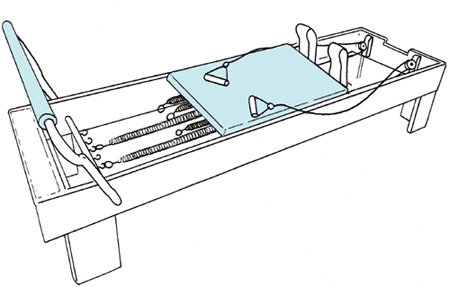
Next page


